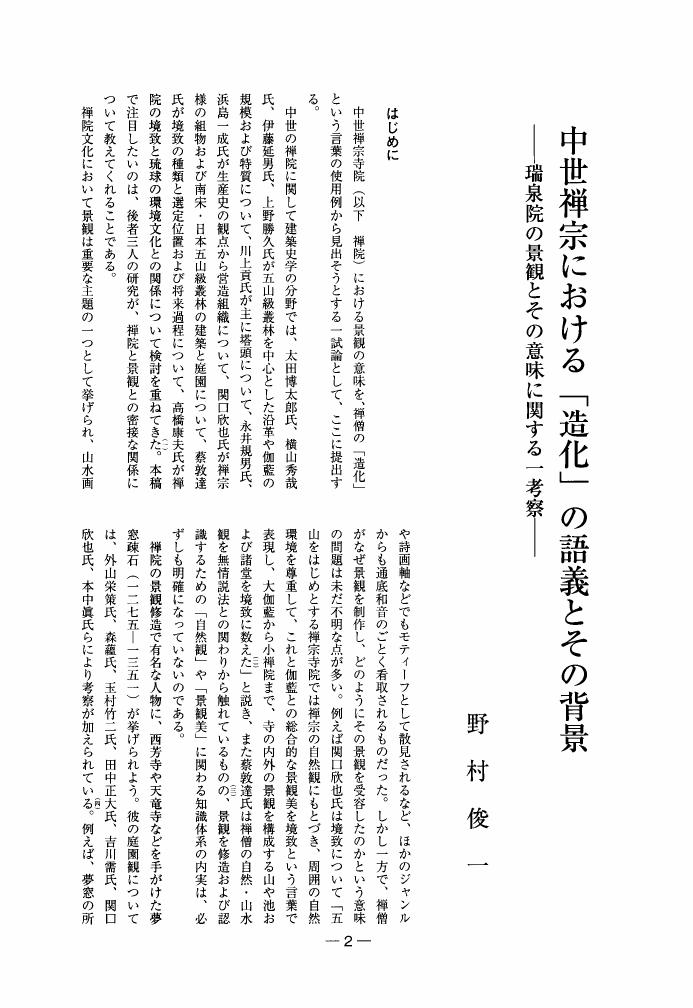2 0 0 0 OA 猪苗代第三・第四発電所と近代化の諸相
- 著者
- 野村 俊一
- 出版者
- 公益社団法人 日本コンクリート工学会
- 雑誌
- コンクリート工学 (ISSN:03871061)
- 巻号頁・発行日
- vol.53, no.8, pp.670-671, 2015 (Released:2016-08-01)
- 参考文献数
- 4
1 0 0 0 OA 中世禅宗における「造化」の語義とその背景 瑞泉院の景観とその意味に関する一考察
- 著者
- 野村 俊一
- 出版者
- 建築史学会
- 雑誌
- 建築史学 (ISSN:02892839)
- 巻号頁・発行日
- vol.48, pp.2-23, 2007 (Released:2018-06-28)
1 0 0 0 OA 中世における瑞泉寺の規模と特質について
- 著者
- 野村 俊一
- 出版者
- 日本建築学会
- 雑誌
- 日本建築学会計画系論文集 (ISSN:13404210)
- 巻号頁・発行日
- vol.69, no.580, pp.189-196, 2004-06-30 (Released:2017-02-09)
- 参考文献数
- 52
- 被引用文献数
- 1 1
The purpose of this paper is clarify the scale and feature of Zuisenji temple in the medieval ages. A summary will be given as foUows : 1. Zuisenji temple which Muso Soseki established was a small-scale life space centering on hojo. This life space is similar with the environment where it is located in the back part of Gosan of south Sung or Kamakura of the same age. 2. If based that kyochi of zen sect temple concentrated in the circumference of hojo in future.'Zuisenji temple is positioned as a forerunner of the environment which suited composing gatha. 3. When Gido Shushin became "juji", the scale of Zuisenji temple was expanded aiming at "jissatu" for expansion of denomination. Consequently, the scale near the so-called composition of "sichido garan" was realized. 4. Each descent of the scale and social background of Zuisenji temple corresponded mostly.
1 0 0 0 猪苗代第三・第四発電所と近代化の諸相
- 著者
- 野村 俊一
- 出版者
- 公益社団法人 日本コンクリート工学会
- 雑誌
- コンクリート工学 (ISSN:03871061)
- 巻号頁・発行日
- vol.53, no.8, pp.670-671, 2015
1 0 0 0 OA 被災・破損を起因とする建設の技術革新と建築様式に関する歴史的研究
- 著者
- 藤井 恵介 川本 重雄 平山 育男 溝口 正人 後藤 治 大野 敏 藤川 昌樹 光井 渉 大橋 竜太 清水 重敦 藤原 重雄 加藤 耕一 角田 真弓 野村 俊一 上野 勝久
- 出版者
- 東京大学
- 雑誌
- 基盤研究(A)
- 巻号頁・発行日
- 2013-04-01
本研究は、日本の建築と都市にかかわって、<天災・人災→被害→修理・再建・再生>というプロセスについて、日本の7世紀から20世紀まで、実例を調査、収集する。そして特にその際に起きた技術革新と建築様式の変化を明らかにすることが目的である。主要な成果は以下の通り。①安元3年(1177)に起きた京都大火と治承4年(1180)の南都焼討は、大仏様を誘発する契機となり、和様を中心様式から引きずり下ろした。②明治24年の濃尾地震(1891)は、その後の近代建築の耐震性上昇などの大きな誘因となった。しかし、被害が過剰に報告されるなど、情報が操作された点も多い。

